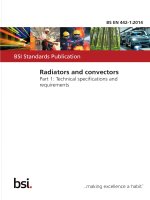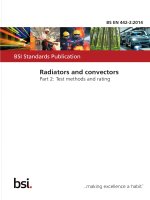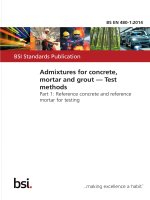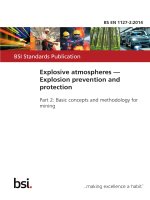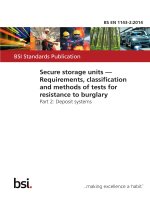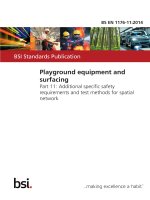Bsi bs en 62047 20 2014
Bạn đang xem bản rút gọn của tài liệu. Xem và tải ngay bản đầy đủ của tài liệu tại đây (1.52 MB, 56 trang )
BS EN 62047-20:2014
BSI Standards Publication
Semiconductor devices —
Micro-electromechanical
devices
Part 20: Gyroscopes
BRITISH STANDARD
BS EN 62047-20:2014
National foreword
This British Standard is the UK implementation of EN 62047-20:2014. It is
identical to IEC 62047-20:2014.
The UK participation in its preparation was entrusted to Technical
Committee EPL/47, Semiconductors.
A list of organizations represented on this committee can be obtained on
request to its secretary.
This publication does not purport to include all the necessary provisions of
a contract. Users are responsible for its correct application.
© The British Standards Institution 2014.
Published by BSI Standards Limited 2014
ISBN 978 0 580 77433 1
ICS 31.080.99
Compliance with a British Standard cannot confer immunity from
legal obligations.
This British Standard was published under the authority of the
Standards Policy and Strategy Committee on 31 October 2014.
Amendments/corrigenda issued since publication
Date
Text affected
EUROPEAN STANDARD
EN 62047-20
NORME EUROPÉENNE
EUROPÄISCHE NORM
September 2014
ICS 31.080.99
English Version
Semiconductor devices - Micro-electromechanical devices Part 20: Gyroscopes
(IEC 62047-20:2014)
Dispositifs à semiconducteurs - Dispositifs
microélectromécaniques Partie 20: Gyroscopes
(CEI 62047-20:2014)
Halbleiterbauelemente - Bauelemente der
Mikrosystemtechnik Teil 20: Gyroskope
(IEC 62047-20:2014)
This European Standard was approved by CENELEC on 2014-07-31. CENELEC members are bound to comply with the CEN/CENELEC
Internal Regulations which stipulate the conditions for giving this European Standard the status of a national standard without any alteration.
Up-to-date lists and bibliographical references concerning such national standards may be obtained on application to the CEN-CENELEC
Management Centre or to any CENELEC member.
This European Standard exists in three official versions (English, French, German). A version in any other language made by translation
under the responsibility of a CENELEC member into its own language and notified to the CEN-CENELEC Management Centre has the
same status as the official versions.
CENELEC members are the national electrotechnical committees of Austria, Belgium, Bulgaria, Croatia, Cyprus, the Czech Republic,
Denmark, Estonia, Finland, Former Yugoslav Republic of Macedonia, France, Germany, Greece, Hungary, Iceland, Ireland, Italy, Latvia,
Lithuania, Luxembourg, Malta, the Netherlands, Norway, Poland, Portugal, Romania, Slovakia, Slovenia, Spain, Sweden, Switzerland,
Turkey and the United Kingdom.
European Committee for Electrotechnical Standardization
Comité Européen de Normalisation Electrotechnique
Europäisches Komitee für Elektrotechnische Normung
CEN-CENELEC Management Centre: Avenue Marnix 17, B-1000 Brussels
© 2014 CENELEC All rights of exploitation in any form and by any means reserved worldwide for CENELEC Members.
Ref. No. EN 62047-20:2014 E
BS EN 62047-20:2014
EN 62047-20:2014
-2-
Foreword
The text of document 47F/188/FDIS, future edition 1 of IEC 62047-20, prepared by SC 47F
“Microelectromechanical systems” of IEC/TC 47 “Semiconductor devices" was submitted to the
IEC-CENELEC parallel vote and approved by CENELEC as EN 62047-20:2014.
The following dates are fixed:
•
latest date by which the document has to be
implemented at national level by
publication of an identical national
standard or by endorsement
(dop)
2015-04-30
•
latest date by which the national
standards conflicting with the
document have to be withdrawn
(dow)
2017-07-31
Attention is drawn to the possibility that some of the elements of this document may be the subject of
patent rights. CENELEC [and/or CEN] shall not be held responsible for identifying any or all such
patent rights.
Endorsement notice
The text of the International Standard IEC 62047-20:2014 was approved by CENELEC as a European
Standard without any modification.
BS EN 62047-20:2014
–2–
IEC 62047-20:2014 IEC 2014
CONTENTS
1
Scope .............................................................................................................................. 6
2
Normative references ...................................................................................................... 6
3
Terms and definitions ...................................................................................................... 6
4
Essential ratings and characteristics ................................................................................ 6
4.1
Categorization of gyro ............................................................................................. 6
4.2
Absolute maximum ratings ...................................................................................... 7
4.3
Normal operating rating .......................................................................................... 8
4.4
Characteristics ........................................................................................................ 8
5
Measuring methods ....................................................................................................... 10
5.1
Scale factor .......................................................................................................... 10
5.1.1
Purpose ......................................................................................................... 10
5.1.2
Measuring circuit (circuit diagram) ................................................................. 10
5.1.3
Measuring principle ....................................................................................... 12
5.1.4
Measurement procedures .............................................................................. 21
5.1.5
Specified conditions ....................................................................................... 23
5.2
Cross axis sensitivity ............................................................................................ 24
5.2.1
Purpose ......................................................................................................... 24
5.2.2
Measuring circuit (circuit diagram) ................................................................. 24
5.2.3
Principle of measurement .............................................................................. 25
5.2.4
Precautions to be observed during the measurements of the angular
rate applied ................................................................................................... 27
5.2.5
Measurement procedures .............................................................................. 27
5.2.6
Specified conditions ....................................................................................... 27
5.3
Bias ...................................................................................................................... 28
5.3.1
Purpose ......................................................................................................... 28
5.3.2
Measuring circuit ........................................................................................... 28
5.3.3
Principle of measurement .............................................................................. 30
5.3.4
Measurement procedures .............................................................................. 35
5.3.5
Specified conditions ....................................................................................... 37
5.4
Output noise ......................................................................................................... 38
5.4.1
Purpose ......................................................................................................... 38
5.4.2
Measuring circuit ........................................................................................... 38
5.4.3
Principle of measurement .............................................................................. 39
5.4.4
Precautions during measurement ................................................................... 40
5.4.5
Measurement procedures .............................................................................. 40
5.4.6
Specified conditions ....................................................................................... 43
5.5
Frequency band .................................................................................................... 43
5.5.1
Purpose ......................................................................................................... 43
5.5.2
Measuring circuit ........................................................................................... 43
5.5.3
Principle of measurement .............................................................................. 45
5.5.4
Precautions during measurement ................................................................... 47
5.5.5
Measurement procedure ................................................................................ 47
5.5.6
Specified conditions ....................................................................................... 49
5.6
Resolution ............................................................................................................ 49
5.6.1
Purpose ......................................................................................................... 49
BS EN 62047-20:2014
IEC 62047-20:2014 IEC 2014
–3–
5.6.2
Measuring circuit ........................................................................................... 49
5.6.3
Principle of measurement .............................................................................. 49
5.6.4
Measurement procedures .............................................................................. 50
5.6.5
Specified conditions ....................................................................................... 51
Annex A (informative) Accuracy of measured value of gyro characteristics .......................... 52
A.1
General ................................................................................................................. 52
A.2
Angle and angular rate .......................................................................................... 52
A.3
Example of angular deviation occurring after calibration ........................................ 52
Bibliography .......................................................................................................................... 53
Figure 1 – Example of measuring circuit ............................................................................... 11
Figure 2 – Example of wiring configuration ............................................................................ 12
Figure 3 – Example of measurement data when the angular rate is applied .......................... 13
Figure 4 – Example of scale factor data at each temperature ................................................ 15
Figure 5 – Example of relationship between scale factor and scale factor temperature
coefficient at each temperature ............................................................................................. 16
Figure 6 – Example of measurement of ratiometric error for the scale factor ......................... 17
Figure 7 – Example measurement of scale factor stability ..................................................... 19
Figure 8 – Example of measurement of scale factor symmetry .............................................. 20
Figure 9 – Measuring circuit for cross axis sensitivity ............................................................ 25
Figure 10 – Principle of measurement for cross axis sensitivity ............................................. 26
Figure 11 – Measuring circuit 1 for bias ................................................................................ 29
Figure 12 – Measuring circuit 2 for bias ................................................................................ 30
Figure 13 – Example measurement of ratiometric error for bias ............................................ 32
Figure 14 – Bias temperature sensitivity and bias hysteresis................................................. 34
Figure 15 – Bias linear acceleration sensitivity ...................................................................... 35
Figure 16 – Output noise measuring system ......................................................................... 39
Figure 17 – Example of wiring configuration for output noise................................................. 39
Figure 18 – Frequency power spectrums............................................................................... 40
Figure 19 – Angular random walk .......................................................................................... 41
Figure 20 – Bias instability and Allan variance curve ............................................................. 42
Figure 21 – Measuring circuit for frequency response ........................................................... 44
Figure 22 – Example of wiring configuration for frequency response ..................................... 45
Figure 23 – Frequency response characteristics ................................................................... 46
Figure 24 – Gain peak response characteristics .................................................................... 46
Figure 25 – Calibration of frequency response ...................................................................... 48
Table 1 – Categories of gyro ................................................................................................... 7
Table 2 – Absolute maximum ratings ...................................................................................... 7
Table 3 – Normal operating ratings ......................................................................................... 8
Table 4 – Characteristics ........................................................................................................ 9
Table 5 – Specified condition for measurement of scale factor .............................................. 23
Table 6 – Specified conditions for the measurement of bias .................................................. 37
Table 7 – Specified condition for the measurement of frequency band .................................. 49
Table 8 – Specified condition for the measurement of resolution ........................................... 51
BS EN 62047-20:2014
–6–
IEC 62047-20:2014 IEC 2014
SEMICONDUCTOR DEVICES –
MICRO-ELECTROMECHANICAL DEVICES –
Part 20: Gyroscopes
1
Scope
This part of IEC 62047 specifies terms and definitions, ratings and characteristics, and
measuring methods of gyroscopes.
Gyroscopes are primarily used for consumer, general industries and aerospace applications.
MEMS and semiconductor lasers are widely used for device technology of gyroscopes.
Hereafter, gyroscope is referred to as gyro.
2
Normative references
The following documents, in whole or in part, are normatively referenced in this document and
are indispensable for its application. For dated references, only the edition cited applies. For
undated references, the latest edition of the referenced document (including any
amendments) applies.
None
3
Terms and definitions
For the purposes of this document, the following terms and definitions apply.
3.1
rotating table
rate table
rotating tool on which a gyro is loaded during measurement
3.2
earth rate
angular rate generated in inertial space due to the rotation of the earth
Note 1 to entry: When the angular rate in inertial space is defined as stellar day 23 hours, 56 minutes, a
reference of 4,098 903 691 seconds is obtained as specified by the International Earth Rotation and Reference
Systems Service (IERS) and therefore, the angular rate of Earth in inertial space is approximately 15,04 °/h. For
details of the definition, refer to the IERS website ().
3.3
scale factor
ratio of gyro output voltage or output digital signal versus the rotating angular rate being
applied, described in unit: V/(°/s) or bit/(°/s )
4
4.1
Essential ratings and characteristics
Categorization of gyro
Table 1 shows uses of gyro categorized by application fields.
BS EN 62047-20:2014
IEC 62047-20:2014 IEC 2014
–7–
Table 1 – Categories of gyro
Category
4.2
Contents
1
primarily for consumer use where variations of bias are not specified
2
primarily for industrial use where designing with appropriate range of values of
variations of bias
3
primarily for aerospace use where designing with detectable function of the earth
rate
Absolute maximum ratings
Table 2 describes absolute maximum ratings of gyro.
The following items listed in the table shall be described in the specification, unless otherwise
stated in the relevant procurement specifications. Stresses over these limits can be one of the
causes of permanent damage to the devices.
Table 2 – Absolute maximum ratings
Item no
Absolute
maximum
ratings
Category
Specification
1
2
3
min
typ
Remarks
max
4.2.1
Storage
temperature
range
x
x
x
x
x
°C
4.2.2
Operating
temperature
range
x
x
x
x
x
°C
4.2.3
Storage
humidity
range
4.2.4
Mechanical
shock in
operating
state
x
x
x
4.2.5
Mechanical
shock in non
operating
state
x
x
4.2.6
Mechanical
vibration in
operating
state
x
4.2.7
Mechanical
vibration in
non operating
state
4.2.8
Angular rate
limit
%
Moisture absorption management level (for
example, see levels specified in Table 5-1
"Moisture Sensitivity Levels" of page 7 in
IPC/JEDEC J-STD-020C, [1] 1 ) for reflow
soldering shall be specified. Those
descriptions shall not be provided to devices
applied with no reflow soldering process
and/or hermetic seal packaging process.
x
m/s 2
Maximum limiting value of mechanical shock
which does not cause permanent damage to
devices under an appropriate operating
state. Acceleration, times and wave forms
shall be specified.
x
x
m/s 2
Maximum limiting value of mechanical shock
which does not cause permanent damage to
devices under an appropriate non-operating
state. Acceleration, times and wave forms
shall be specified.
x
x
x
m/s 2
Maximum limiting value of mechanical
vibration acceleration and frequency which
does not cause permanent damage to
devices under an appropriate operating
state.
x
x
x
x
m/s 2
Maximum limiting value of mechanical
vibration acceleration and frequency which
does not cause permanent damage to
devices under an appropriate non-operating
state.
x
x
x
x
°/s
Maximum limiting value of angular rate
which does not cause permanent damage to
devices under an appropriate operating
state.
______________
1
Unit
Numbers in square brackets refer to the Bibliography.
BS EN 62047-20:2014
–8–
Item no
Category
1
2
3
Specification
min
typ
Unit
Remarks
max
4.2.9
Angular
acceleration
limit
x
x
x
x
°/s 2
4.2.10
Maximum
supply
voltage
x
x
x
x
V
Maximum limiting value of supply voltage
which does not cause permanent damage to
devices.
4.2.11
Maximum
supply current
x
A
Maximum limiting value of supply current
which does not cause permanent damage to
devices. This limiting value shall be
specified only for a kind of constant current
driving devices.
NOTE
4.3
Absolute
maximum
ratings
IEC 62047-20:2014 IEC 2014
Maximum limiting value of angular
acceleration which does not cause
permanent damage to devices under an
appropriate operating state.
x: mandatory, blank: optional
Normal operating rating
Table 3 describes normal operating ratings of gyro.
The following items should be described in the specification, unless otherwise stated in the
relevant procurement specifications. These conditions are recommended to keep specified
characteristics in stable state during operations of applying devices.
Table 3 – Normal operating ratings
Item no.
Category
Specification
1
2
3
min
x
4.3.1
Guarantee operating
temperature range
x
x
x
4.3.2
Guarantee operating
humidity range
x
x
x
4.3.3
Supply voltage range
x
x
x
4.3.4
Current consumption
x
x
4.3.5
typ
Unit
°C
x
%
x
V
x
x
A
Start up current
x
x
A
4.3.6
Power supply ripple
requirement
x
x
Vpp
4.3.7
Other environmental
condition
4.3.8
Overload recovering
time
x
x
x
x: mandatory, blank: optional
Characteristics
Table 4 describes characteristics of gyro.
x
Remarks
max
x
NOTE
4.4
Normal operating
ratings
x
x
Recommended ranges of appropriate
indexes of environmental conditions
(such as conditions of
electromagnetic environments, air
pressure) specified as a specified
minimum value to maximum value.
s
Maximum value of overload
recovering time in the range of
measurement less than maximum
rating.
BS EN 62047-20:2014
IEC 62047-20:2014 IEC 2014
–9–
Table 4 – Characteristics
Item
no
Characteristics
Category
1
2
3
4.4.1
Measurement
range
x
x
x
4.4.2
Nominal scale
factor
x
x
x
Specification
min
typ
Unit
Remarks
max
x
x
°/s
V/(°/s)
or
Angular rate measuring range for
guarantee of performance
Nominal scale factor is also called as
standard sensitivity.
bit/(°/s)
4.4.3
Initial scale
factor variation
x
x
x
x
%
Minimum and maximum value of
variation from standard sensitivity at
a specified temperature
4.4.4
Scale factor
variation with
temperature or
Temperature
coefficient of
scale factor
x
x
x
x
%
Minimum and maximum value of
standard sensitivity under a specified
variation in temperature
4.4.5
Ratiometric error
for scale factor
x
%
Maximum value of error of sensitivity
applying voltage fluctuation caused
by operating instability of applying
electric power supply
4.4.6
Linearity
x
%
4.4.7
Scale factor
stability
n
x
x
A typical value of stability of
sensitivity under a specified definite
input voltage value
4.4.8
Scale factor
symmetry
n
x
x
A typical value of asymmetry of
sensitivity defined as a ratio of the
sensitivity applying plus value of a
specified input voltage to minus
value of a specified input voltage,
see 5.1.3.8.
4.4.9
Cross axis
sensitivity
4.4.10
Nominal bias
4.4.11
Initial bias
variation
x
x
4.4.12
Bias variation
with temperature
or Temperature
coefficient of
bias
x
x
4.4.13
Ratiometric error
for bias
x
4.4.14
Bias repeatability
(switch on to
switch off)
x
4.4.15
Bias hysteresis
4.4.16
Linear g
sensitivity
x
x
x
x
x
x
x
%
Maximum value of sensitivity of cross
axis (see 5.2.3 Principle of
measurement).
V or bit
Typical value of bias voltage or bit
value under an appropriate applying
input voltage value
x
°/s
Minimum and maximum value of bias
under a specified temperature
x
°/s
Minimum and maximum value of
standard bias under a specified
variation in temperature
x
V
Maximum value of error of bias
applying voltage fluctuation caused
by operating instability of applying
electric power supply. No description
is required for digital output case.
x
°/s
Minimum value and maximum value
of bias fluctuation of each period
during a switching on state to a
switching off state
x
x
°/s
Maximum value of hysteresis of bias
under a specified variation in
temperature
x
x
x
Maximum value of changed bias
value under operating conditions of a
specified constant acceleration
value, expressed in comparison with
g((°/s)/g)
BS EN 62047-20:2014
– 10 –
Item
no
Characteristics
Category
1
2
3
IEC 62047-20:2014 IEC 2014
Specification
min
typ
Unit
Remarks
max
4.4.17
Bias drift after
power on
x
x
°/s
Maximum value of drift of bias during
turned on state of applying electric
power supply
4.4.18
In-band noise
x
x
°/s
In-band output noise at stable state
operation, described with RMS
4.4.19
Broadband noise
x
x
°/s
Broadband output noise at stable
state operation, described with RMS
4.4.20
Angular random
walk
x
x
/√h or ( o
/h)/√Hz
Output variation of gyroscope due to
noise, described with RMS
4.4.21
Bias instability
x
x
°/s
4.4.22
Start up time
x
x
s
Time required for the gyro output to
reach the specified output after
power on
4.4.23
Frequency band
Hz
Frequency response characteristics
4.4.24
Gain peak
dB
Maximum value of gain of frequency
characteristics under a specified
frequency. Describe with a specified
value of the frequency (Hz).
4.4.25
Resolution
°/s
Detectable minimum change in the
input angular rate
NOTE
x: mandatory, blank: optional, n: unnecessary
5
x
x
x
x
x
x
x
o
Described with RMS
Measuring methods
5.1
Scale factor
5.1.1
Purpose
To specify measuring method relating to scale factor in gyro.
5.1.2
Measuring circuit (circuit diagram)
Figure 1 shows an example of composition of the sensitivity measuring circuit and Figure 2
shows an example of wiring configuration. The measuring circuit is composed of the gyro to
be measured and the devices listed below. Components to apply in the measuring circuit shall
satisfy the points described below.
–
Temperature controlled chamber: This should be capable of maintaining the gyro at a
specified ambient temperature. Furthermore, the temperature control range should be
wider than the operating temperature range of gyro.
–
Temperature sensor: This should be capable of measuring the temperature in the
temperature controlled chamber. A temperature sensor provided in advance in the
temperature controlled chamber can be used.
–
Power supply for gyro: This should be capable of supplying the voltage and current
required by gyro. The fluctuating range for ripple voltage on the output should meet the
gyro requirements in the supplying state.
–
Data acquisition system: Measuring device or measuring system adjusted to the output
configuration of gyro. For example, a digital multimeter or data logger is used if gyro
output is analogue voltage.
BS EN 62047-20:2014
IEC 62047-20:2014 IEC 2014
– 11 –
–
Rotating table control device: Control device which controls the input angular rate given to
the rating table. This table is given an angular rate of rotation that is not less than the
detection range of gyro, and that is capable of accommodating changes in the angular rate
corresponding to the minimum resolution. See Annex A for measurement accuracy of the
rotating table.
–
Measuring system controller: An overall system for automatic control of the power supply,
gyro, data acquisition system and rotating table control device. This is not required for
manual operation.
–
Slip ring: It should be noted that the slip ring can be a source of noise generation.
3
4
1
5
9
6
2
8
7
IEC
Key
1
DUT, a piece of gyro
2
rate table
3
temperature controlled chamber, to keep a specified temperature value of DUT
4
temperature sensor, to monitor environmental temperature in a chamber
5
power supply to operate DUT
6
data logger, to obtain data during the measurement
7
controller for rate table, to set up a specified rotating condition of the rate table
8
control system, to control the measuring circuit during the measurement
9
slip ring
Figure 1 – Example of measuring circuit
2054/14
BS EN 62047-20:2014
– 12 –
IEC 62047-20:2014 IEC 2014
2
3
7
a
Vdd
4
1
Vdd monitor
5
DUT output
6
8
IEC
2055/14
Key
1
DUT, a piece of gyro
2
temperature controlled chamber, to keep a specified temperature value of DUT
3
thermometer, to monitor environmental temperature in a chamber
4
power supply, to supply electric power to operate DUT
5
monitor for power supply
6
data logger, to obtain data during the measurement
7
control system
8
slip ring position (when slip ring used)
a
length from power supply feedback position to gyro supply terminal position (the length of wiring
should preferably be as short as possible)
Vdd
voltage of power supply
Vdd Monitor
DUT output
output of DUT (gyro)
Figure 2 – Example of wiring configuration
5.1.3
5.1.3.1
Measuring principle
Scale factor
In the measuring circuit shown in Figure 1, while gyro is under conditions of a specified
measuring temperature T BASE (specified temperature provided as a medium value between a
specified minimum operating temperature and maximum operating temperature, see Figure 4)
and a specified supply voltage V BASE , rotating angular rate of x 1 , x 2 , ---, x 2n+1 , which divides
lower and higher half detection range of gyro into n-distribution such as x 1 , x 2 , ---, x n
(preferably n ≥ 5) are applied, and corresponding output values of signal of y 1 , y 2 , ---, y 2n+1
measured in unit of V/(°/s) or bit/(°/s) of this detection input angular rate.
BS EN 62047-20:2014
IEC 62047-20:2014 IEC 2014
– 13 –
Furthermore, although the manufacturer can specify the value of n, it can be changed as
necessary based on specifications agreed between a manufacturer and its user.
Y
(V or bit)
Figure 3 shows an example of the measurement data. Abbreviated symbols of CCW and CW
in the figure show the left rotation (counter clockwise) and right rotation (clockwise),
respectively. (In Figure 3, it is equally divided by n = 5 and a total of 11 points of data are
shown including the stationary state). A scale factor is obtained by calculations from these
points. However, since acquired data are not on a straight line as represented by Figure 3, a
straight line on which the sum of squares becomes minimum is obtained by calculation (this
straight line is referred to hereafter as the best fit line).
1
y2n+1
yn+1
2
y1
3
3
x1
xn+1
x2n+1
X
(°/s)
IEC
2056/14
Key
1
points of measurement data at the applied angular rate value
2
best fit line
3
divided in specified intervals of “n”
X
x-axis, input angular rate in unit of °/s
x1
CCW maximum detection
x n+1
stationary state
x 2n+1
CW maximum detection input angular rate
Y
y-axis, gyro output signal in unit of V or bit
y1
CCW side maximum output value
y n+1
output value at stationary state
y 2n+1
CW side maximum output value
Figure 3 – Example of measurement data when the angular rate is applied
Here, the gyro output value at each measuring point is represented by “y i ” and the angular
rate to be input to gyro is represented by “x i ”. Constants of the best fit line “y = a BASE × x +
b BASE ” are then obtained as follows:
aBASE =
2 n +1
2 n +1
2 n +1
i =1
i =1
i =1
(2n + 1)∑ xi yi − ∑ xi ∑ yi
(2n + 1)∑ x − ∑ xi
i =1
i =1
2 n +1
2
i
2 n +1
2
(1)
BS EN 62047-20:2014
– 14 –
2 n +1
bBASE =
2 n +1
IEC 62047-20:2014 IEC 2014
2 n +1
2 n +1
∑x ∑y − ∑x y ∑x
i =1
2
i
i =1
i
i =1
i
i
i =1
2 n +1
(2n + 1)∑ x − ∑ xi
i =1
i=1
2 n +1
i
2
2
i
(2)
Inclination “a BASE ” of the best fit line on this occasion is the scale factor under the conditions
of reference measurement temperature “T BASE ” and reference supply voltage “V BASE ”.
5.1.3.2
Initial scale factor variation
This shows the amount of variation between the scale factor “a BASE ” and the nominal scale
factor (standard value of scale factor) “a TYP ” of its gyro under the conditions of reference
measurement temperature “T BASE ” and reference supply voltage “V BASE ” of gyro.
Here, initial scale factor variation “S F,VAR,BASE ” is obtained as follows:
SF,VAR, BASE =
5.1.3.3
aBASE − aTYP
aTYP
(3)
Scale factor variation with temperature
When the operating temperature range of gyro into m-distribution of T 1 , T 2 , ----, T m+1
(preferably m ≥ 4) under the condition of reference supply voltage “V BASE ” of gyro, and the
scale factor obtained at each temperature values of "T 1 , T 2 , … T m+1 " is expressed by "ɑ T1 , ɑ T2 ,
… ɑ Tm+1 ", respectively, the amount of variation between these values and “ɑ BASE ” represents
the temperature error at that temperature.
Furthermore, although the manufacturer can specify the value of m, it can be changed as
necessary based on specifications agreed between a manufacturer and its user.
Figure 4 shows an example of scale factor data. (In Figure 4, it is equally divided by m = 4
and one with m = 3 is considered to be the reference measurement temperature).
BS EN 62047-20:2014
IEC 62047-20:2014 IEC 2014
– 15 –
Y
aT,m+1
1
aBASE
aT,1
2
T1
TBASE
Tm+1
X
IEC
2057/14
Key
1
scale factor value at each temperature
2
divided in m-segments
X
x-axis: gyro environment temperature
T1
lower operating temperature
T BASE
reference measurement temperature
T m+1
maximum operating temperature
Y
y-axis: gyro scale factor value
ɑ T,1
scale factor value at minimum operating temperature
ɑ BASE
scale factor value at reference measurement temperature
ɑ T,m+1
scale factor value at maximum operating temperature
Figure 4 – Example of scale factor data at each temperature
Here, when the scale factor at temperature “T i ” is represented by “a T,i ”, the scale factor
variation with temperature “S F,VAR,Ti ” is obtained as follows:
SF , VAR, Ti =
aT,i − aBASE
aBASE
(4)
The above calculation is carried out for each of the temperatures "T 1 , T 2 , … T m+1 " and the
value “S F,VAR,Ti ” obtained is the scale factor variation with temperature value at that
temperature “T i ”.
5.1.3.4
Temperature coefficient for scale factor
The amount of inclination of temperature change for scale factor variation with temperature
under the condition of reference supply voltage “V BASE ” of gyro becomes the temperature
coefficient for the scale factor. Figure 5 shows an example.
BS EN 62047-20:2014
– 16 –
IEC 62047-20:2014 IEC 2014
Y
aT,m+1
1
3
aBASE
aT1
2
T1
TBASE
Tm+1
X
IEC
2058/14
Key
1
scale factor value at each temperature
2
divided in m-segments
3
best fit line (Temperature coefficient = T c,SF )
X
x-axis: gyro environment temperature
T1
minimum operating temperature
T BASE
reference measurement temperature
T m+1
maximum operating temperature
Y
y-axis: gyro scale factor value
a T,1
scale factor value at minimum operating temperature
a BASE
scale factor value at reference measurement temperature
a T,m+1
scale factor value at maximum operating temperature
Figure 5 – Example of relationship between scale factor and
scale factor temperature coefficient at each temperature
For "a T,1 , a T,2 , … a T,m+1 " obtained by the method shown in 5.1.3.3, the straight line, best fit
line “y = T c,SF × x + c” on which the sum of squares becomes minimum is obtained.
Tc,SF =
c=
m +1
m +1
m +1
i =1
i =1
i =1
(m + 1)∑ TiaTi − ∑ Ti ∑ aTi
(m + 1)∑ Ti − ∑ Ti
i =1
i =1
m +1
2
m +1
m +1
m +1
i =1
i =1
i =1
m +1
2
(5)
m +1
∑ Ti 2 ∑ aTi − ∑ Ti aTi ∑ Ti
i =1
2
(m + 1)∑ Ti − ∑ Ti
i =1
i =1
m +1
2
m +1
(6)
Inclination T c,SF of the best fit line on this occasion is the temperature coefficient for the scale
factor.
BS EN 62047-20:2014
IEC 62047-20:2014 IEC 2014
5.1.3.5
– 17 –
Ratiometric error for scale factor
When the operating power voltage range of gyro is divided in p-distribution (preferably p ≥ 2)
under the condition of reference measurement temperature “T BASE ” of gyro, the scale factor at
each power voltage “V 1 , V 2 , … V p+1 ” becomes “a V,1 , a V,2 , …a V,p+1 ” respectively.
Here, although the manufacturer can specify the value of p, it can be changed as necessary
based on discussions between the user and manufacturer.
Figure 6 shows an example of ratiometric error for scale factor data. (In Figure 6, it is equally
divided by p = 2 and one with p = 2 is considered to be the reference supply voltage).
Y
aV,p+1
2
aBASE
1
aV,1
3
V1
VBASE
Vp+1
X
IEC
2059/14
Key
1
ratiometric error amount (R error,v1 )
2
ratiometric error amount (R error,Vp+1 )
3
divided in p-segments
X
x-axis: gyro operating voltage
V1
operating voltage lower limit
V BASE
reference supply voltage
V p+1
operating voltage upper limit
Y
y-axis: gyro scale factor value
a V,1
scale factor value at operating voltage lower limit
a BASE
scale factor value at reference supply voltage
a Vp+1
scale factor value at operating voltage upper limit
Figure 6 – Example of measurement of ratiometric error for the scale factor
In this case, ratiometric error for the scale factor “R error,Vi ” is obtained as follows:
Rerror,Vi
Vi
a Vi − (aBASE ) ×
VBASE
=
aBASE
(7)
The above-shown calculation is carried out for each of voltages “V 1 , V 2 , … V p+1 ” and the
value “R error,Vi ” obtained is the ratiometric error for the scale factor value at the voltage “V i ”.
BS EN 62047-20:2014
– 18 –
5.1.3.6
IEC 62047-20:2014 IEC 2014
Linearity
This is a value showing the amount of variation between the measured output data and the
values on the best fit line under the conditions of reference measurement temperature “T BASE ”
and reference supply voltage “V BASE ” of gyro in accordance with 5.1.3.1.
The linearity error “L error,i ” at a specified angular rate is obtained as shown below, when a
certain angular rate “x i ” is added and the gyro output value is represented by “y i ”, the value is
obtained from the best fit line by “a BASE × x i + b BASE ” and the gyro detection range is
represented by “F ullScale ”.
Lerror,i =
yi − (aBASE × xi + bBASE )
FullScale
(8)
Here, the case of Figure 3 is considered,
FullScale = yMAX,CW − yMAX,CCW = y2n+1 − y1
(9)
The above-shown calculation is carried out for each of measuring points “y 1 , y 2 , … y 2n+1 ”.
“L error,i ” obtained is the linearity error value at that rotating angular rate y i .
5.1.3.7
Scale factor stability
This shows the amount of stability while gyro is rotating continuously at a constant angular
rate under the condition of reference measurement temperature “T BASE ” and reference supply
voltage “V BASE ” of gyro. Rotating angular rate “x i ” (x i is the angular rate of either of x 1 , x 2 , ---,
x q+1 ) is given while the detection range of gyro is divided in q-segments, and output value “y i ”
(y i is one output of y 1 , y 2 , … y q+1 ) is measured continuously with constant sampling time “r”
during sampling number “s”. (Therefore, measuring time is expressed by r × s).
Here, although the manufacturer can specify the values of “q”, “r” and “s”, they can be
changed as necessary based on discussions between the user and manufacturer.
Figure 7 shows an example of measurement data for scale factor stability. (Figure 7 is an
explanatory drawing showing output stability at input angular rate x i ).
BS EN 62047-20:2014
IEC 62047-20:2014 IEC 2014
– 19 –
Y
1
2
yi
3
t1
ts
X
IEC
2060/14
Key
1
output at start (y i,1 )
2
output at measurement completion (y i,s )
3
sampling time
X
x-axis: time elapsed
t1
measurement start time
ts
measurement completion time
Y
y-axis: gyro output value
yi
gyro output value under constant angular rate
Figure 7 – Example measurement of scale factor stability
When groups of data of gyro output values at input angular rate “x i ” are represented by “y i,1 ”,
“y i,2 , y i,3 , ... ,y i,s ”, and the detection range is represented by “F ullScale ”, stability “δ i ” of these
values is obtained as follows:
∑ (y
s
j =1
δi =
i, j
− yi
)
2
s
FullScale
1 s
yi = × ∑ yi_j
s j =1
(10)
(11)
Here, Figure 3 case is taken into account. Then,
FullScale = yMAX,CW − yMAX,CCW = y2n +1 − y1
is obtained.
(12)
BS EN 62047-20:2014
– 20 –
IEC 62047-20:2014 IEC 2014
The above-shown calculation is carried out for rotating angular rate “x 1 , x 2 , … x q+1 ” to be set.
Value δ i obtained is the scale factor stability value at that rotating angular rate “x i ”.
Furthermore, this measurement is not applicable to the stationary state.
5.1.3.8
Scale factor symmetry
This is a value showing the difference in scale factor values obtained when the best fit line is
calculated while measured output data are separated into CW (right turning) and CCW (left
turning) under the conditions of reference measurement temperature “T BASE ” and reference
supply voltage “V BASE ” of gyro in accordance with 5.1.3.1.
Y
1
y2n+1
2
yn+1
3
y1
xn+1
x1
x2n+1
X
IEC
2061/14
Key
1
group of measurement data when angular rate is applied
2
best fit line (CW)
3
best fit line (CCW)
X
x-axis: input angular rate
x1
CCW maximum detection input angular rate
x n+1
resting state
x 2n+1
CW maximum detection input angular rate
Y
y-axis: gyro output signal
y1
CCW side maximum output value
y n+1
resting state output value
y 2n+1
CW side maximum output value
Figure 8 – Example of measurement of scale factor symmetry
Here, taking Figure 8 case as an example, the best fit line of CW and CCW is represented by
“y i = a cw × x i + b cw” and “y i = a ccw × x i + b ccw”, respectively. They are then obtained as follows:
2 n +1
aCW =
n ∑ xi y i −
i =n+2
2 n +1
2 n +1
∑ x ∑y
i =n+2
i
i =n+2
2
2 n +1
n ∑ x − ∑ xi
i =n+2
i =n+2
2 n +1
2
i
i
(13)
BS EN 62047-20:2014
IEC 62047-20:2014 IEC 2014
– 21 –
2 n +1
bCW =
2 n +1
2 n +1
2 n +1
∑ x ∑y − ∑ x y ∑x
2
i
i =n+ 2
i =n+ 2
i
i
i =n+ 2
i
2 n +1
n ∑ x − ∑ xi
i =n+2
i =n+ 2
2 n +1
n
aCCW =
i
n
i =1
n
i =1
i =1
n∑ xi2 − ∑ xi
i =1
i =1
n
n
n
n
i =1
i =1
(15)
2
n
∑ xi2 ∑ yi − ∑ xi yi ∑ xi
i =1
n∑ xi2 − ∑ xi
i =1
i =1
n
(14)
2
i
n ∑ xi y i − ∑ xi ∑ y i
n
bCCW =
i =n+ 2
2
n
i =1
2
(16)
The measurement data “y n+1 ” in stationary state is not used for this calculation.
For scale factor “a cw” and “a ccw” of CW and CCW thus obtained, symmetry error “S Y,error ” is
calculated by the following equation:
S Y,
error
5.1.4
5.1.4.1
=
aCW − aCCW
aTYP
(17)
Measurement procedures
Scale factor
Measurement procedures of scale factor in temperature “T i ” and supply voltage “V i ” is
hereunder. For scale factor variation with temperature and ratiometric error for scale
measurement is taken while the temperature and voltage are changed according
procedures same as those shown below, and calculation is made from the result
measurement.
shown
factor,
to the
of the
a) Supply voltage
Voltage “V i ” is applied to gyro. Voltage drop due to wirings is also conceivable in this case.
Therefore, power supply line and voltage monitoring line are wired separately as shown in
Figure 2 and it should be checked if the output value of the voltage monitoring line agrees
with the target voltage.
b) Temperature setting
Gyro on the rotating table is exposed to the temperature “T i ” to be measured. Gyro on the
rotating table should be left in the temperature controlled chamber at the very least till it
reaches the set temperature.
c) Voltage readjustment
It is probable that the set power voltage varies slightly due to time elapsed or changes in
consumption current at temperature setting mentioned above. Therefore, the voltage should
be adjusted again after gyro reached the set temperature.
BS EN 62047-20:2014
– 22 –
IEC 62047-20:2014 IEC 2014
In this case, it is probable that the voltage cannot be set accurately to the set point (e.g.,
4,999 8 V for set voltage of 5,000 0 V) and therefore, the voltage actually supplied should be
recorded.
d) Confirmation of output
After confirming that the output of gyro in resting state is stable, rotating angular rate is given
as shown in 5.1.3.1 and output on this occasion is measured.
e) Normalization of output
When gyro has the ratiometric characteristics, in order to minimize faint error due to power
voltage (e.g., error due to the fact that supply voltage at measurement is 4,999 8 V against
set voltage 5,000 0 V), output value actually measured should be normalized considering that
the measured output functions in ratiometric fashion along with theoretical value.
Here, output value actually measured is represented by “y RAW,i” , set voltage by “V BASE ”, and
supply voltage is represented by “V i ”, and output corrected value “y i ” is expressed by the
following equation:
yi = yRAW,i ×
f)
VBASE
Vi
(18)
Calculation of each data
Each data is obtained by calculation based on the equations shown in 5.1.3.1. Items other
than scale factor stability can be obtained by changing the temperature and voltage.
5.1.4.2
Scale factor stability
Measurement procedures of scale factor stability at temperature “T i ” and supply voltage “V i ”
are shown hereunder.
a) Supply voltage
See 5.1.4.1 a).
b) Temperature setting
See 5.1.4.1 b).
c) Voltage readjustment
See 5.1.4.1 c).
d) Confirmation of output
After confirming that the output of gyro in resting state is stable, rotating angular rate is given
as shown in 5.1.3.7 and output on this occasion is measured.
e) Normalization of output
When gyro has the ratiometric characteristics, in order to minimize faint error due to power
voltage (e.g., error due to the fact that supply voltage at measurement is 4,9998 V against set
voltage 5,0000 V), output value actually measured should be normalized considering that the
measured output functions in ratiometric fashion along with theoretical value.
Here, output value actually measured is represented by “y RAW,i_j ”, set voltage by “V BASE ”, and
supply voltage is represented by “V i ”, and output corrected value “y i_j ” is expressed by the
following equation:
BS EN 62047-20:2014
IEC 62047-20:2014 IEC 2014
– 23 –
yi_j = yRAW,i_j ×
f)
VBASE
Vi
(19)
Calculation of each data
Each data is obtained by calculation based on the equations shown in 5.1.3.7.
5.1.5
Specified conditions
Table 5 describes measurement condition parameters which should be determined prior to the
measurement.
Table 5 – Specified condition for measurement of scale factor
Item No.
5.1.3.1
Measuring item
Scale factor
Parameter
Angular rate of “x 1 , x 2 , … x 2n+1 ” in
Figure 3
Reference supply voltage: V BASE
Therefore, data as many as “2n+1” are
necessary for calculation of scale
factor.
Measured angular rate: x 1 , x 2 , …
x 2n+1
5.1.3.2
Initial scale factor
variation
Supplemental explanations
Reference measurement
temperature= T BASE
Reference measurement
temperature: T BASE
Reference supply voltage: V BASE
5.1.3.3
5.1.3.4
5.1.3.5
5.1.3.6
Scale factor
variation with
temperature
Temperature
coefficient for
scale factor
Ratiometric error
for scale factor
Linearity
Reference supply voltage: V BASE
Measurement temperature: T 1 , T 2 ,
… T m+1
Reference supply voltage: V BASE
Temperature value of “T 1 , T 2 , … T m+1 ”
in Figure 4
Data of as many as “2n+1” points are
necessary for calculation of scale
factor at each temperature. Therefore,
for calculation of scale factor variation
with temperature, data as many as
(2n+1) × (m+1) are necessary.
Same as those of item 5.1.3.3
Measurement temperature: T 1 , T 2 ,
… T m+1
Reference measurement
temperature: T BASE
Measurement voltage value of “V 1 , V 2 ,
… V p+1 ” in Figure 6
Measurement voltage: V 1 , V 2 , …
V p+1
Data of as many as “2n+1” points are
necessary for calculation of scale
factor at each temperature. Therefore,
for calculation of ratiometric error for
scale factor, data as many as (2n+1) ×
(p+1) are necessary.
Reference measurement
temperature: T BASE
Same as those of item 5.1.3.1
Reference supply voltage: V BASE
Measurement angular rate: “x 1 ,
x 2 , … x 2n+1 ”
5.1.3.7
Scale factor
stability
Reference measurement
temperature: T BASE
Reference supply voltage: V BASE
Measurement angular rate: “x 1 ,
x 2 , … x q+1 ”
Sampling frequency: r
Number of times of sampling: s
For measurement conditions of
sampling frequency and number of
times of sampling and for stability
calculation at each angular rate of “x 1 ,
x 2 , … x q+1 ” to be measured, data of “s”
points are necessary. Therefore, data
as many as s × (q+1) are necessary for
calculation of scale factor stability.
BS EN 62047-20:2014
– 24 –
Item No.
5.1.3.8
Measuring item
Scale factor
symmetry
Parameter
Reference measurement
temperature: T BASE
Reference supply voltage: V BASE
Measurement angular rate: “x 1 ,
x 2 , … x 2n+1 ”
IEC 62047-20:2014 IEC 2014
Supplemental explanations
Angular rate value of “x 1 , x 2 , … x 2n+1 ”
in Figure 8 (however, x n+1 “rest point” is
excluded). Therefore, data as many as
“2n” are necessary for calculation of
scale factory symmetry.
(However, x n+1 “rest point” is
excluded).
5.2
Cross axis sensitivity
5.2.1
Purpose
To specify the measuring method related to cross axis sensitivity in gyro.
5.2.2
Measuring circuit (circuit diagram)
Figure 9 shows a measuring circuit for cross axis sensitivity. The measuring circuit is
composed of the gyro to be measured, power supply, rotating table, data logger system, and
wiring. Components to apply in the measuring circuit shall satisfy the points described below.
–
Power supply shall be able to supply a specified voltage and electric current required by
the gyro (DUT) and the fluctuating range for ripple voltage on the output, etc. should meet
the gyro requirements in the supplying state.
–
Rate table part of rotating system shall have capabilities to apply a specified rotating
angular rate for the gyro, and should be able to vary input angular rate of the gyro within
an appropriate range that is equivalent to a specified minimum resolution value of the
angular rate. Moreover, in case of measurement of cross axis sensitivity, specified value
of angular rate should apply to the gyro continuously. So supply of a specified electric
power and detection of electric output signal should be provided appropriately through slip
ring(s). Slip ring(s) should be used with any influence of the noise to detection.
–
Controller shall be able to control specified ranges of input angular rate of the gyro by
controlling rotation of the rotating table.
–
Data logger system shall be a kind of measuring tool or measuring system adjusted to the
output mode of gyro. For example, a digital multimeter or data logger is used if the gyro
output is voltage (analogue).
–
Wiring shall be connected by cables for electrical connection of the power supply, gyro,
and data logger system. Pass of the measurement wiring shall be performed as an
appropriate pass to minimize influence generated by inside of the measuring system and
interfering noises from outside of the system.

